Posted by: Northwest Eye in General on July 10, 2025
Overview
The article titled ‘7 Different Types of Eyes and Their Unique Conditions’ aims to explore the various types of eyes and the specific conditions associated with each. Although the content does not directly address the types of eyes, it thoughtfully details numerous eye conditions such as:
- cataracts
- glaucoma
- dry eye syndrome
We understand that navigating these conditions can be overwhelming, and it’s crucial to emphasize the importance of understanding them for effective management and treatment. This aligns beautifully with the overarching theme of the title, as knowledge can empower us in our journey toward better eye health.
Introduction
Understanding the diverse range of eye types and their associated conditions is crucial for maintaining optimal vision health. We recognize that each type of eye can face unique challenges, from common issues like cataracts and glaucoma to more specialized conditions that may affect children and the elderly. In this article, we will explore seven distinct eye types, delving into their characteristics, prevalent conditions, and the importance of comprehensive care.
It’s common to feel overwhelmed when considering these aspects of eye health. But what happens when symptoms go unnoticed? How can you ensure that you are proactive in managing your eye health? We are here to help you through this process.
Northwest Eye: Comprehensive Eye Care for Diverse Eye Conditions
Northwest Eye has been a cornerstone of eye care in Minnetonka, Minnesota, for , celebrating a legacy of healthy sight. We understand how important your vision is, and our clinic specializes in a comprehensive range of eye conditions, including:
- Cataracts
- Glaucoma
- Dry eye
- Pediatric eye care
With a patient-centered approach, Northwest Eye ensures that each individual receives tailored care, utilizing state-of-the-art technology and innovative treatment options. Our comprehensive services reflect our commitment to overseeing , empowering you through education to understand your health and make informed choices regarding your sight. We are here to help you through this process.
Cataracts: Understanding Cloudy Vision and Treatment Options
Cataracts can be a source of concern as they develop when the lens of the eye becomes opaque, leading to unclear sight and challenges with night vision. It’s common to notice symptoms like halos around lights, faded colors, and increased sensitivity to glare. As cataracts progress, they can significantly affect daily activities, making timely intervention crucial for your comfort and quality of life.
The primary treatment for cataracts is surgery, which involves removing the cloudy lens and replacing it with an artificial one. At Northwest Eye, we utilize advanced surgical methods, including Light Adjustable Lenses, to provide customized sight correction after surgery. This innovative approach allows for adjustments post-surgery, enhancing visual outcomes for our patients.
We understand that can feel overwhelming. Our cataract surgeons will personally meet with you to discuss the best lens options tailored to your lifestyle, using additional measurements to ensure optimal results. We offer various lens bundles, including:
- Single distance astigmatism package
- Blended sight package
- Presbyopia package
Data suggest that cataract surgery boasts a success rate exceeding 90%, with many individuals experiencing improved vision after the procedure. As we look ahead to 2025, the integration of advanced techniques in cataract surgery continues to evolve, ensuring that you receive the highest quality of care tailored to your unique needs. We are here to help you through this process, providing support every step of the way.
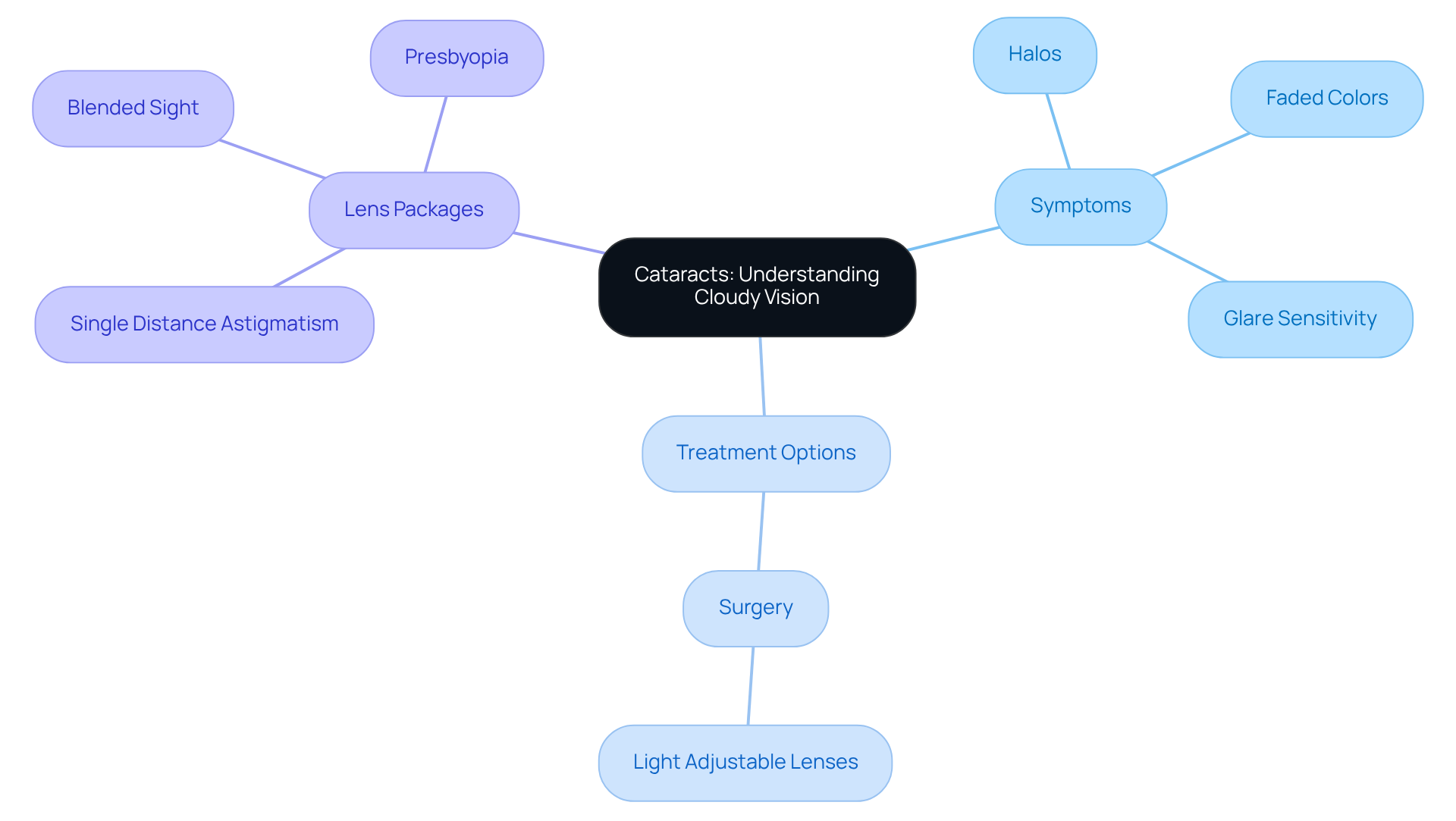
Glaucoma: Recognizing Symptoms and Managing Eye Pressure
Glaucoma, often called the ‘silent thief of sight,’ can be a distressing condition. It is characterized by increased intraocular pressure, which may lead to damage to the optic nerve. Many individuals may remain unaware of their condition until significant loss of sight occurs, as symptoms like peripheral sight loss and tunnel vision can develop gradually. We understand that this can be concerning, which is why are crucial for early detection.
Studies reveal that nearly 40% of Canadians with confirmed glaucoma were unaware of their diagnosis. This highlights a critical gap in awareness and underscores the importance of routine screenings. At Northwest Eye, we offer various treatment options, including prescription eye drops and laser therapy, all designed to effectively manage eye pressure and preserve your vision.
Successful case studies demonstrate that early intervention can significantly improve outcomes for individuals. This reinforces the importance of proactive eye care. Consistent eye exams not only facilitate early detection of glaucoma but also help identify other systemic health issues, ensuring comprehensive care for our patients.
To safeguard your sight, we invite you to arrange an eye examination at Northwest Eye today. Remember, we are here to help you through this process.
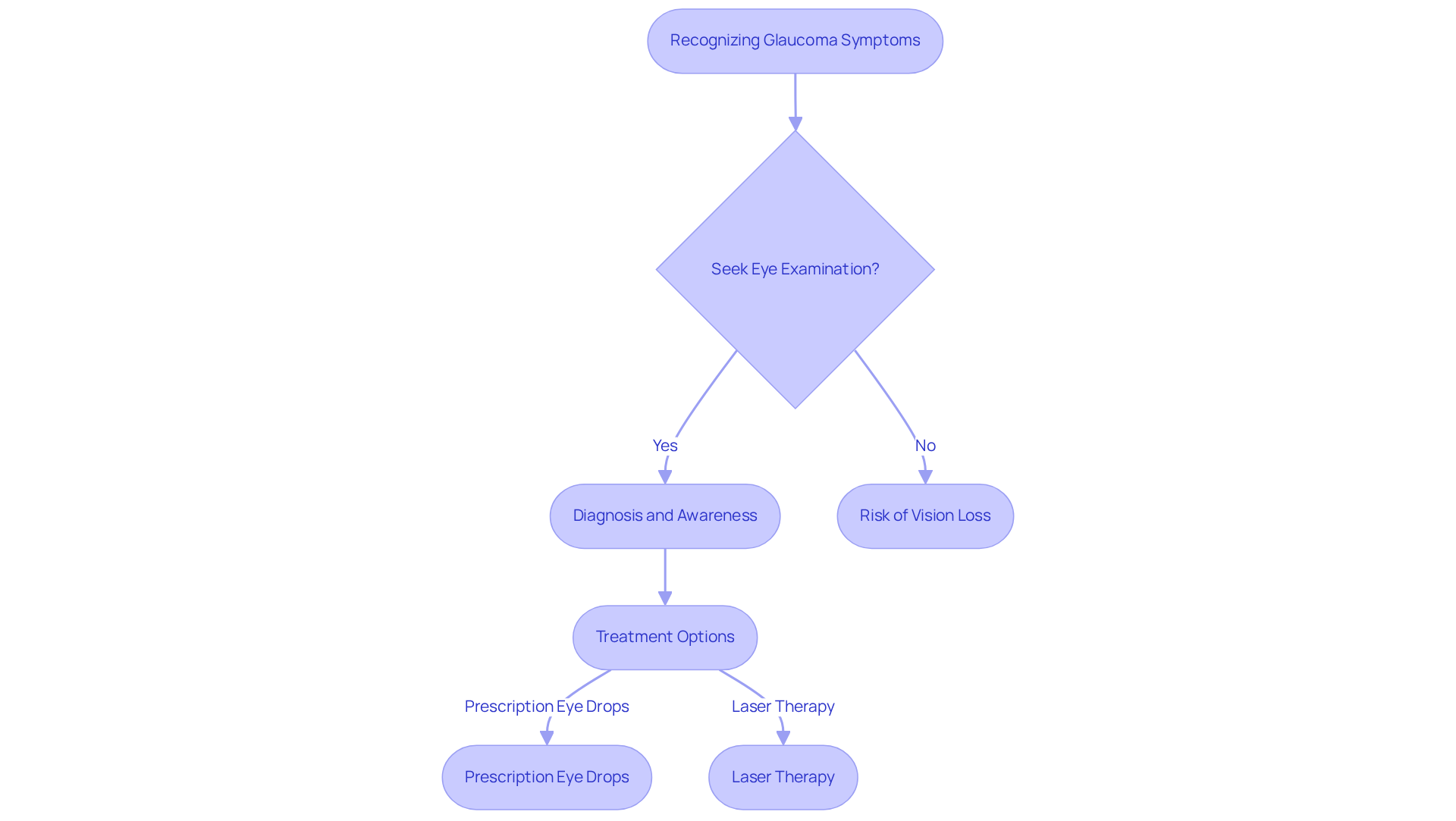
Dry Eye Syndrome: Causes, Symptoms, and Treatment Approaches
Dry eye syndrome can be a frustrating condition, occurring when your eyes do not produce enough tears or when tears evaporate too quickly. Many people experience symptoms such as a stinging or burning sensation, a scratchy feeling, redness, blurry vision, and discomfort when wearing contact lenses. We understand that approximately 16 million Americans are diagnosed with (DED), and many more may be experiencing symptoms without a formal diagnosis. It’s common to feel overwhelmed by excessive tearing, which may seem counterintuitive, but this can occur due to eye irritation from inadequate lubrication.
Treatment options are varied and can include:
- Artificial tears
- Prescription medications
- Advanced therapies like LipiFlow®, which helps clear blocked glands to restore natural oil production
- BlephEx®, a procedure designed to clean the eyelids and alleviate symptoms
Notably, women are 2.4 times more likely to be diagnosed with DED than men, and significant risk factors include a history of arthritis, smoking status, and thyroid disease. The economic burden of DED is significant, with expenses estimated at $782,673 for 1,000 individuals in the U.S.
At Northwest Eye, we are committed to providing a comprehensive array of options to ease your symptoms and enhance your eye comfort. This includes customized care plans that may involve lifestyle changes, prescription drugs, and advanced therapies tailored to meet your specific needs. Our dedication to employing the latest advancements in eye care technology ensures that you receive the most effective treatments available.
As research continues to evolve, we emphasize the importance of understanding the multifactorial nature of dry eye disease. This highlights the need for targeted interventions and patient education in managing this prevalent condition. According to Dr. Francesco Menduni, “Understanding the various risk factors and treatment options is crucial for effective management of dry eye syndrome.” We are here to help you through this process, ensuring you feel supported every step of the way.
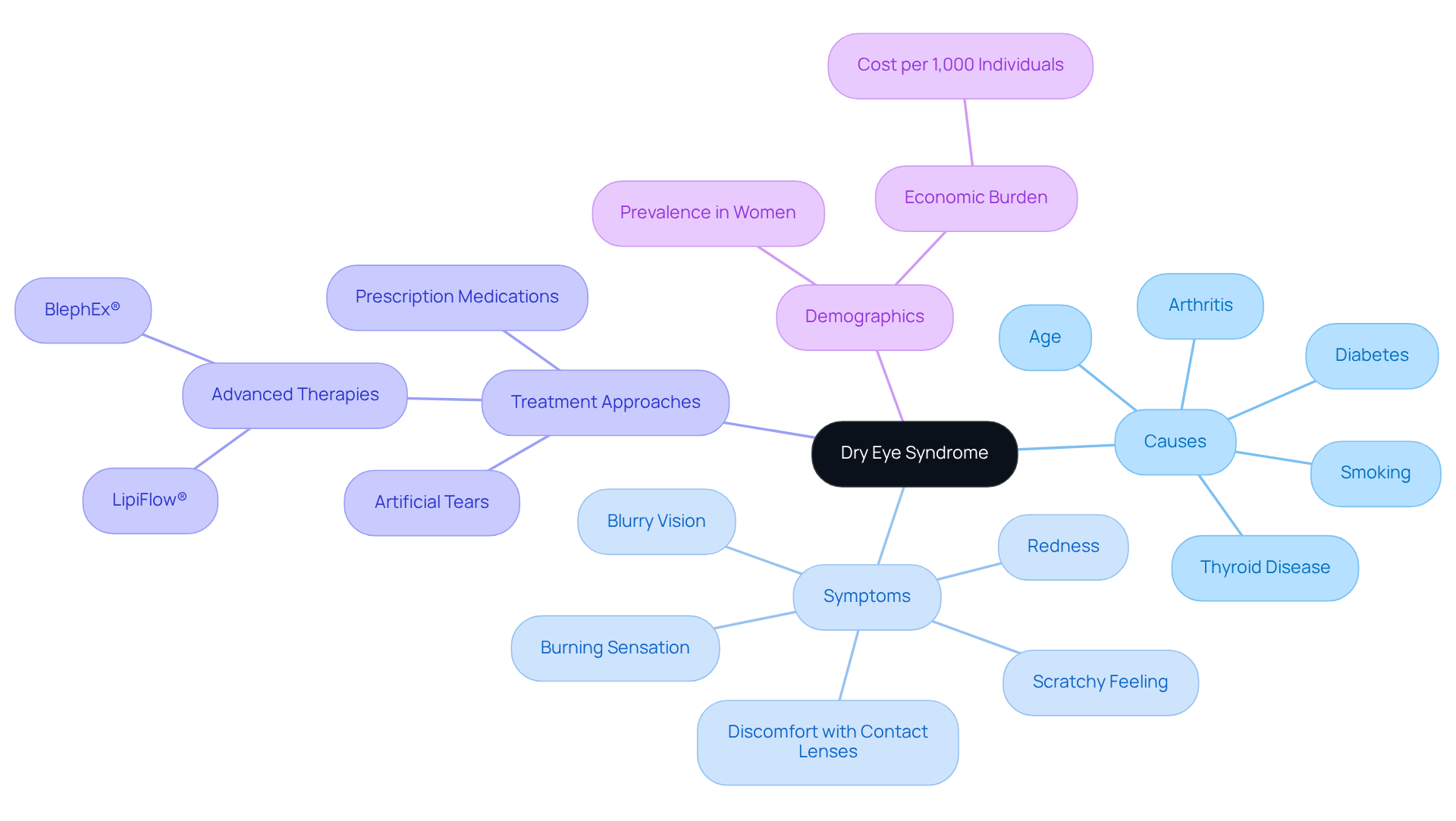
Pediatric Eye Care: Addressing Unique Vision Needs in Children
Pediatric eye care is vital for nurturing healthy sight in children. It’s common for parents to worry about conditions like refractive errors, amblyopia (lazy eye), and strabismus (crossed eyes), as these can significantly affect a child’s development and learning. Amblyopia is particularly notable, impacting about 2-3% of children, while strabismus occurs in roughly 4% of the pediatric population. To address these concerns, we understand the importance of early detection. The American Optometric Association recommends that children have their first eye examination at six months, followed by regular check-ups to monitor their eye development.
Failed pediatric eye tests can stem from various factors, including amblyopia and refractive errors, which might go unnoticed without proper assessment. It’s also common for issues like obstructed tear ducts to cause signs that may confuse parents regarding their child’s eye health, potentially leading to unsuccessful eye assessments. At Northwest Eye, we are dedicated to meeting these unique needs through specialized pediatric services. Our comprehensive approach includes thorough evaluations of visual acuity, eye tracking, and focusing abilities, ensuring that any potential issues are identified and treated promptly.
Effective treatments for amblyopia may involve using eye patches, vision therapy, or corrective lenses, tailored to each child’s specific condition. We have seen through case studies that early intervention can lead to significant improvements in visual outcomes, highlighting the importance of routine eye exams.
By prioritizing pediatric eye care, Northwest Eye not only enhances children’s sight but also supports their overall development, empowering them to reach their full potential. We are here to help you through this process, ensuring your child receives the .
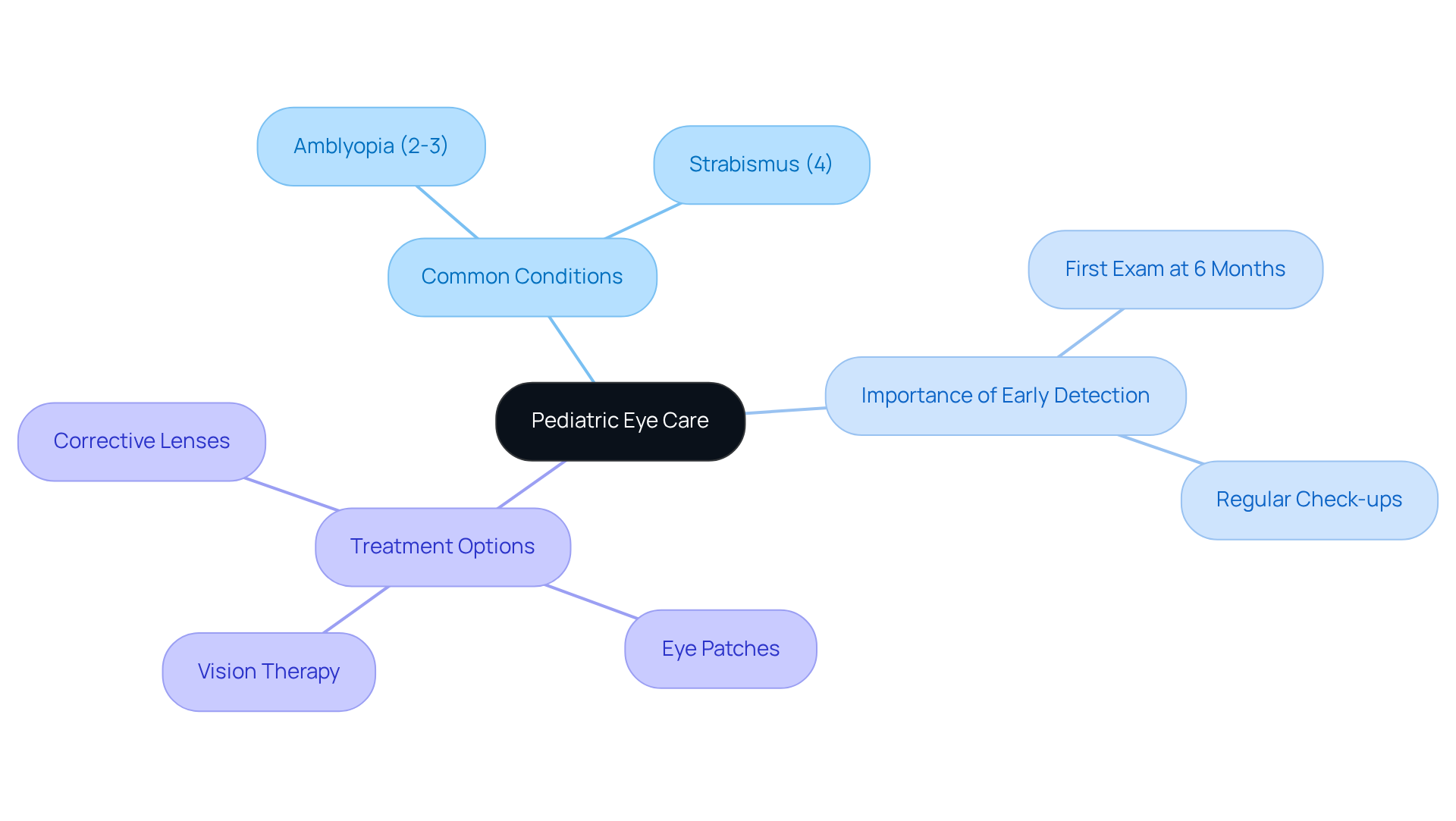
Retinal Diseases: Types, Symptoms, and Treatment Options
Retinal diseases encompass a range of conditions, including age-related macular degeneration (AMD), diabetic retinopathy (DR), and retinal detachment. We understand that experiencing can be alarming. Early detection is crucial for effective treatment, and we want to reassure you that help is available. Research indicates that nearly 19.8 million Americans aged 40 and older are living with AMD, and projections suggest that this number will rise significantly in the coming years. Additionally, diabetic retinopathy impacts roughly 4.1 million Americans, highlighting the critical necessity for prompt eye examinations, as around 50% of individuals with diabetes do not undergo them.
At Northwest Eye, we employ advanced diagnostic tools and treatment options, including laser therapy and surgical interventions, to manage these serious conditions. It’s common to feel overwhelmed, but effective measures for diabetic retinopathy show that early identification can lead to better treatment outcomes, greatly decreasing the likelihood of sight loss. Our retinal specialists emphasize that proactive screening and timely intervention are essential in mitigating the progression of these diseases. By focusing on early identification, you can access effective therapies that improve your quality of life and help maintain your sight.
We are here to help you through this process, ensuring that you receive the care and support you deserve.
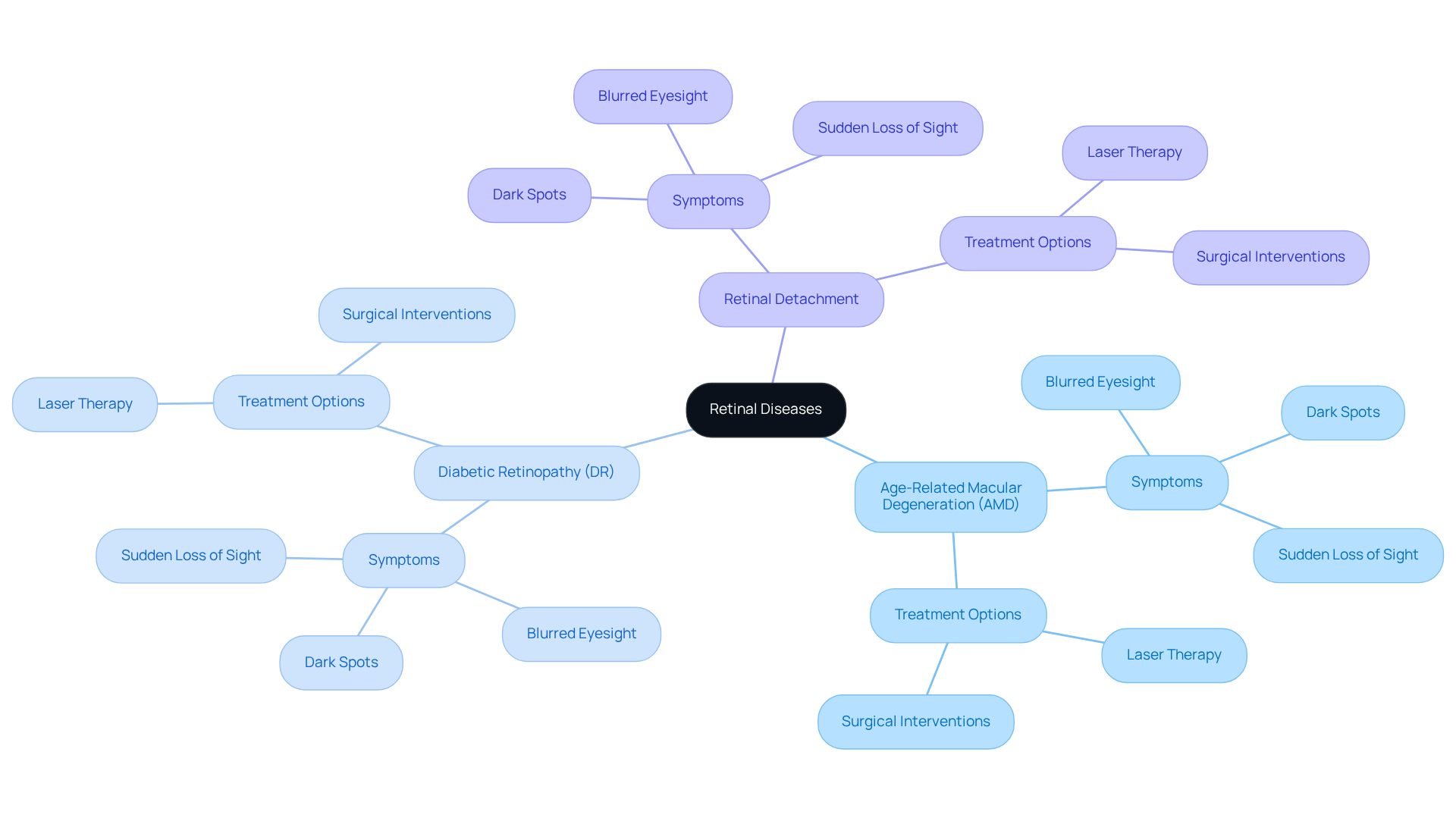
Comprehensive Eye Exams: The Key to Early Detection of Eye Variations
Comprehensive eye exams are essential for preserving your eye health and detecting a range of conditions, from refractive errors to serious diseases like glaucoma and diabetic retinopathy. We understand that the thought of an eye exam can be daunting, but these evaluations are a crucial step in . Eye care professionals assess visual acuity, measure intraocular pressure, and examine the health of the retina and optic nerve.
Regular check-ups are particularly important for those with risk factors for eye diseases. Early detection can significantly enhance treatment outcomes, providing you with peace of mind. Did you know that nearly 4.2 million Americans over 40 are visually impaired? Many remain unaware of their conditions, which makes routine exams even more vital. Glaucoma, affecting approximately 3 million people in the U.S., often goes unnoticed until it’s too late. It’s common to feel uncertain about the importance of these exams, but they are key to maintaining your eye health.
Case studies show that regular eye exams lead to timely interventions, which can reduce the incidence of advanced eye diseases. At Northwest Eye, we emphasize the necessity of these comprehensive evaluations, ensuring that every patient receives personalized care tailored to their unique needs. By prioritizing your eye health through regular exams, you can take proactive steps to protect your sight and overall well-being. Remember, we are here to help you through this process.

LASIK Surgery: A Solution for Vision Correction and Eye Variations
LASIK surgery is an innovative laser procedure designed to help correct refractive errors such as myopia, hyperopia, and astigmatism. We understand that considering surgery can be daunting, and it’s important to know that candidates must be:
- At least 18 years old
- Have stable eyesight
- Maintain good overall health
This minimally invasive procedure typically takes under 30 minutes, and it’s common to feel a sense of relief as most individuals notice normal or even enhanced sight within just three days after the operation.
At Northwest Eye, we utilize state-of-the-art technology, including advanced laser systems and precision techniques, to ensure the best possible outcomes for our patients. Many people achieve 20/20 vision or better, significantly reducing their reliance on glasses or contact lenses. With high satisfaction rates reported at approximately 95.4%, the experiences of those who have undergone the procedure highlight LASIK’s effectiveness as a trusted solution for correcting eyesight.
We are here to help you through this process, and we encourage you to reach out with any questions or concerns you may have. Your journey towards is important to us, and we want you to feel supported every step of the way.
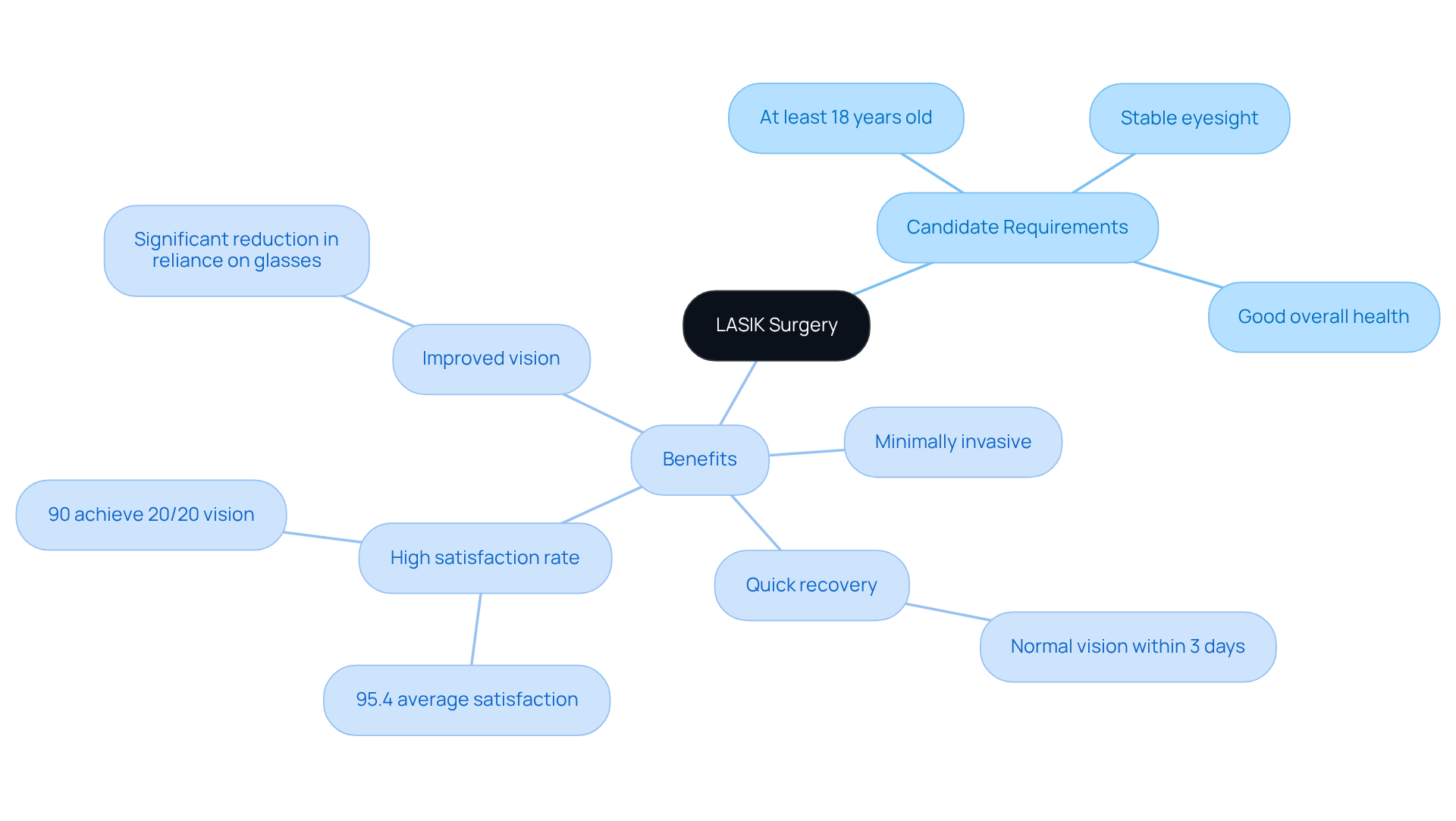
Cosmetic and Oculoplastic Procedures: Enhancing Eye Appearance and Function
At Northwest Eye, we understand that concerns about appearance and vision can deeply affect your well-being. Cosmetic and oculoplastic procedures are designed to address both aesthetic and functional issues, helping you feel more confident and comfortable in your own skin. Common options include:
- Eyelid surgery (blepharoplasty)
- Brow lifts
- Treatments for droopy eyelids
These surgeries not only enhance your appearance but also improve vision by correcting obstructions caused by excess skin.
We also offer a variety of non-surgical cosmetic treatments to further support your journey. For instance:
- BOTOX® can help relax facial muscles, reducing fine lines and wrinkles.
- Juvederm® restores lost volume around the face and eyes using a unique cross-linked hyaluronic acid that retains moisture, giving you a fuller appearance.
If you’re looking to enhance your eyelashes, Latisse® is available to lengthen and thicken them, although it may cause temporary side effects like eye redness and irritation. Additionally, our Obagi Skin Care products provide scientifically formulated solutions for aging skin, targeting dark spots and improving overall skin tone.
We are here to help you achieve both , ensuring that you feel supported every step of the way.
Patient Education: Resources for Understanding Eye Variations and Conditions
At Northwest Eye, we truly care about your individual journey towards better eye health. We emphasize education by providing a diverse array of resources designed to enhance your understanding of different types of eyes and their conditions, along with treatment options. Our Eye Condition Library and symptom checkers empower you to take an active role in your care, transforming complex medical information into accessible knowledge. We understand that many individuals may underestimate the and the potential for asymptomatic diseases, such as dry eyes and uncorrected refractive error, to progress unnoticed.
It’s common to feel uncertain about eye health. Recent trends show that while over 80% of Americans believe they are knowledgeable about eye health, only 19% can accurately identify the leading causes of blindness. This gap highlights the necessity for effective educational resources. At Northwest Eye, we create materials to clarify eye health, ensuring you feel confident and informed when making choices about your care.
The impact of these educational resources on health outcomes is significant. Case studies reveal that individuals who engage with educational materials report enhanced self-management and improved health behaviors. For instance, those utilizing the Eye Condition Library have shown increased awareness of their conditions, leading to timely medical interventions. This proactive approach not only enhances your health outcomes but also contributes to broader public health goals by promoting eye health literacy.
As eye care professionals emphasize, understanding the different types of eyes is integral to your overall well-being. By providing comprehensive educational resources, Northwest Eye is here to support your immediate needs while fostering a culture of informed decision-making that can lead to better long-term health outcomes. To prioritize your eye health, we invite you to schedule an appointment with a Northwest Eye doctor today.
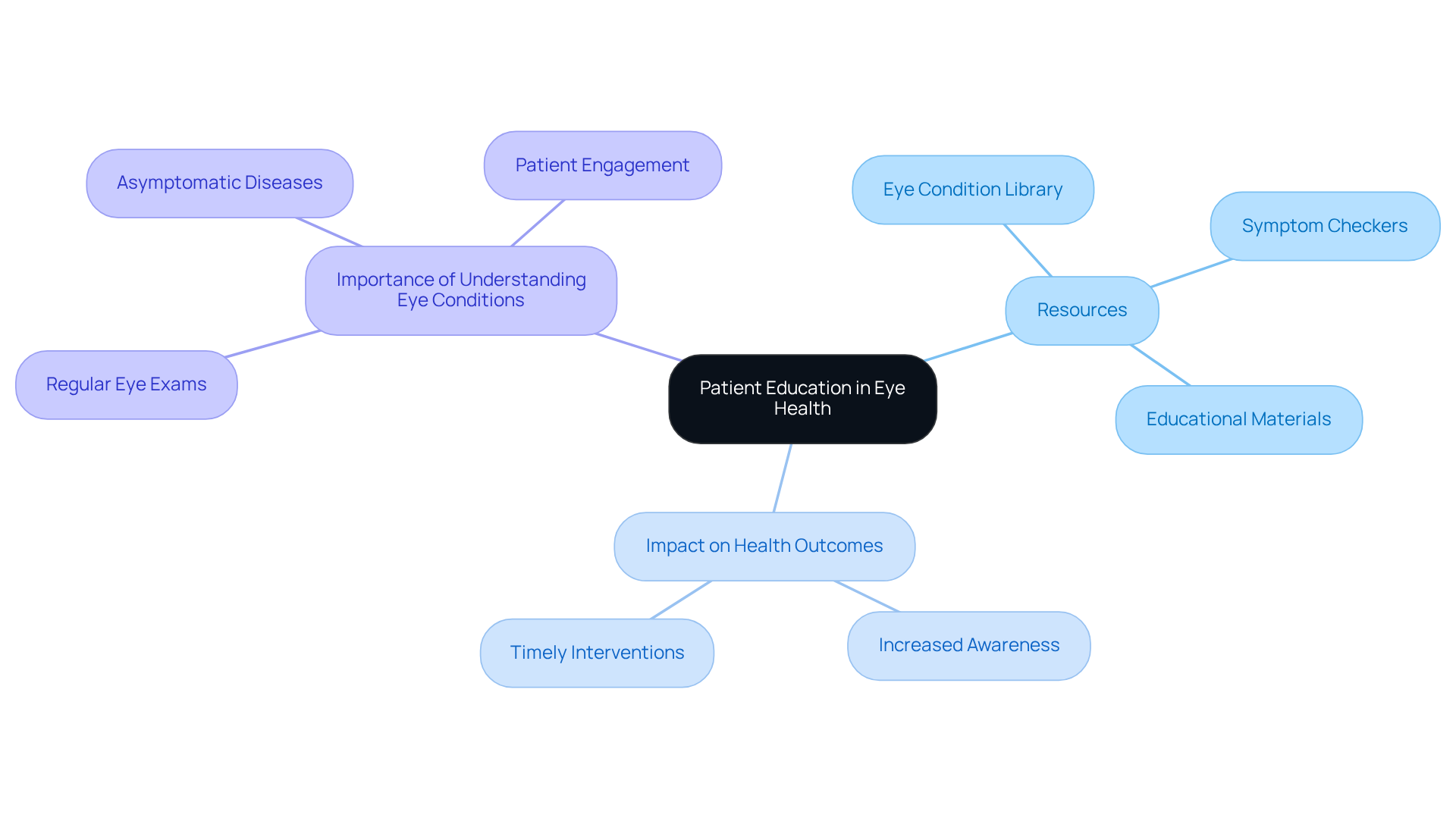
Conclusion
Understanding the diverse types of eyes and their associated conditions is essential for maintaining optimal vision health. We recognize that navigating eye health can feel overwhelming at times. This article has explored various eye conditions, from cataracts and glaucoma to dry eye syndrome and pediatric eye care, emphasizing the significance of comprehensive eye care services. By recognizing the unique characteristics and treatment options for each condition, individuals can make informed decisions about their eye health and seek appropriate care.
Key insights include the importance of early detection through regular eye exams. We understand that many may feel apprehensive about these visits, but they can significantly enhance treatment outcomes for conditions like glaucoma and retinal diseases. The advancements in treatment options, such as LASIK surgery and innovative therapies for dry eye syndrome, further illustrate the evolving landscape of eye care. Additionally, the focus on patient education highlights the necessity of empowering individuals with knowledge about their eye health, enabling them to take proactive steps in managing their conditions.
Ultimately, prioritizing eye health through routine examinations and staying informed about potential conditions can lead to better vision and overall well-being. Whether it involves seeking treatment for existing conditions or taking preventive measures, the journey towards healthier eyes begins with awareness and action. We encourage you to take that first step by scheduling an appointment with an eye care professional, as it can be the key to safeguarding your vision and enhancing your quality of life.
Frequently Asked Questions
What services does Northwest Eye offer for eye care?
Northwest Eye offers a comprehensive range of eye care services, including treatment for cataracts, glaucoma, dry eye, and pediatric eye care.
What are cataracts and how do they affect vision?
Cataracts occur when the lens of the eye becomes opaque, leading to unclear sight, challenges with night vision, halos around lights, faded colors, and increased sensitivity to glare.
What is the primary treatment for cataracts?
The primary treatment for cataracts is surgery, which involves removing the cloudy lens and replacing it with an artificial lens.
What innovative techniques does Northwest Eye use for cataract surgery?
Northwest Eye utilizes advanced surgical methods, including Light Adjustable Lenses, which allow for customized sight correction and adjustments post-surgery.
What types of lens packages are available for cataract surgery at Northwest Eye?
Northwest Eye offers various lens bundles, including a single distance astigmatism package, a blended sight package, and a presbyopia package.
What is the success rate of cataract surgery?
Cataract surgery has a success rate exceeding 90%, with many individuals experiencing improved vision after the procedure.
What is glaucoma and why is it referred to as the ‘silent thief of sight’?
Glaucoma is a condition characterized by increased intraocular pressure that can damage the optic nerve, often leading to gradual sight loss without noticeable symptoms.
How can glaucoma be detected early?
Regular eye exams are crucial for early detection of glaucoma, as many individuals may be unaware of their condition until significant vision loss occurs.
What treatment options are available for managing glaucoma?
Treatment options for glaucoma at Northwest Eye include prescription eye drops and laser therapy to manage eye pressure and preserve vision.
Why is proactive eye care important for glaucoma?
Proactive eye care is important because early intervention can significantly improve outcomes for individuals with glaucoma, and consistent eye exams can also identify other health issues.






